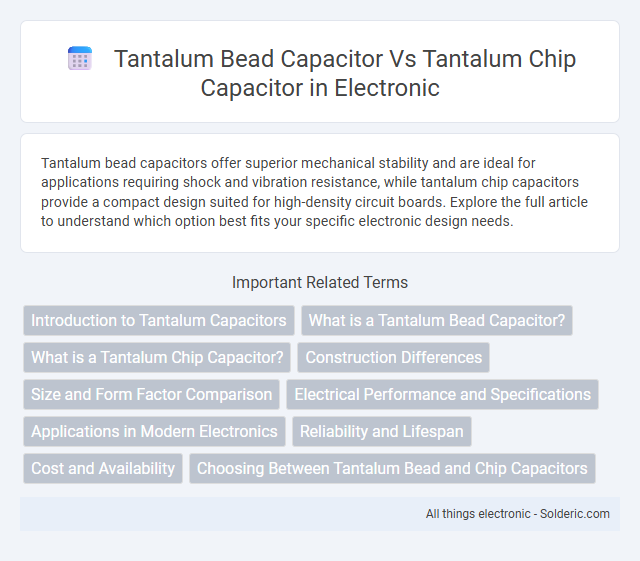Tantalum bead capacitors offer superior mechanical stability and are ideal for applications requiring shock and vibration resistance, while tantalum chip capacitors provide a compact design suited for high-density circuit boards. Explore the full article to understand which option best fits your specific electronic design needs.
Comparison Table
| Feature | Tantalum Bead Capacitor | Tantalum Chip Capacitor |
|---|---|---|
| Form Factor | Small, cylindrical bead shape | Rectangular, flat chip shape |
| Applications | High-reliability circuits, aerospace, military | Consumer electronics, compact circuit boards |
| Capacitance Range | Typically lower capacitance (few nF to uF) | Wide capacitance range (uF to hundreds uF) |
| Voltage Rating | Moderate voltage (up to 50V typical) | Varies widely (up to 100V and beyond) |
| ESR (Equivalent Series Resistance) | Generally higher ESR | Lower ESR for better performance |
| Size | Usually larger due to bead shape | Compact, suitable for surface-mount technology (SMT) |
| Reliability | High reliability in harsh environments | Good reliability with modern manufacturing |
| Mounting | Leaded through-hole mounting | Surface mount technology (SMT) |
Introduction to Tantalum Capacitors
Tantalum bead capacitors are small, cylindrical components ideal for high-reliability applications, offering excellent frequency characteristics and stability. Tantalum chip capacitors, shaped as flat rectangular chips, provide compact size and higher volumetric efficiency, making them suitable for densely populated circuit boards. Both types use tantalum powder anodes with solid or manganese dioxide electrolytes, ensuring high capacitance per volume and long-term reliability in electronic devices.
What is a Tantalum Bead Capacitor?
A tantalum bead capacitor is a small, cylindrical capacitor made by encasing a tantalum anode bead in a solid manganese dioxide or polymer electrolyte. This design offers high capacitance per volume, excellent stability, and reliable performance in filtering and decoupling applications. Compared to tantalum chip capacitors, tantalum bead capacitors typically provide better vibration resistance and are preferred in high-reliability electronic circuits.
What is a Tantalum Chip Capacitor?
A tantalum chip capacitor is a surface-mount electronic component designed for high capacitance in a compact form, using tantalum powder as the anode material. It offers excellent reliability, low equivalent series resistance (ESR), and stable electrical characteristics, making it ideal for applications in consumer electronics, automotive systems, and telecommunications. Compared to tantalum bead capacitors, chip capacitors provide better space efficiency and are suited for automated assembly processes in modern circuit boards.
Construction Differences
Tantalum bead capacitors feature a sintered tantalum powder pellet shaped into a bead, coated with a manganese dioxide or polymer dielectric, and enclosed in epoxy for protection. Tantalum chip capacitors are manufactured as flat, layered structures composed of tantalum anode, dielectric oxide, and cathode layers deposited on a ceramic substrate, resulting in a compact surface-mount design. The bead type offers axial leads for through-hole mounting, while the chip type provides a smaller footprint optimized for high-density PCB assemblies.
Size and Form Factor Comparison
Tantalum bead capacitors typically feature a small, cylindrical form factor with axial leads, making them suitable for through-hole mounting and applications requiring compact, elongated shapes. In contrast, tantalum chip capacitors have a flat, rectangular surface-mount design, optimizing them for high-density circuit boards where minimal vertical space is critical. The chip capacitors generally offer a smaller footprint and lower profile compared to bead capacitors, enhancing integration in modern electronics with stringent size constraints.
Electrical Performance and Specifications
Tantalum bead capacitors typically offer higher voltage ratings and lower equivalent series resistance (ESR) compared to tantalum chip capacitors, making them suitable for high-reliability applications with stable electrical performance. Tantalum chip capacitors, however, provide better volumetric efficiency and are more compact, ideal for surface-mount technology in densely packed circuits. Your choice depends on whether electrical stability under stress (favoring tantalum bead) or size and integration (favoring tantalum chip) is the priority.
Applications in Modern Electronics
Tantalum bead capacitors are widely used in high-frequency circuits and RF applications due to their low inductance and excellent stability, making them ideal for filtering and decoupling in communication devices. In contrast, tantalum chip capacitors excel in compact consumer electronics, such as smartphones and laptops, thanks to their small size and high volumetric efficiency. Your choice between these types depends on the specific performance requirements and space constraints of your modern electronic designs.
Reliability and Lifespan
Tantalum bead capacitors typically offer higher reliability due to their robust construction and lower risk of mechanical failure compared to tantalum chip capacitors. Your choice impacts lifespan significantly, as bead capacitors generally exhibit better performance under stress and high-temperature conditions, leading to longer operational life. Tantalum chip capacitors, while compact, may face increased failure rates in harsh environments due to solder joint fatigue and electrolyte degradation.
Cost and Availability
Tantalum bead capacitors generally have lower manufacturing costs due to simpler production and are more readily available in some legacy or niche applications. Tantalum chip capacitors, benefiting from modern surface-mount technology, often command higher prices but offer better scalability in mass production, leading to improved availability for automated assembly lines. Market availability for both types varies by supplier and region, with chip capacitors more common in contemporary electronics and bead capacitors favored for specific high-reliability needs.
Choosing Between Tantalum Bead and Chip Capacitors
Tantalum bead capacitors offer high capacitance in a compact, cylindrical form ideal for through-hole mounting, providing superior mechanical stability and reliable performance in high-voltage applications. Tantalum chip capacitors, with their surface-mount design, excel in automated assembly processes and are preferred for miniaturized circuit boards requiring low equivalent series resistance (ESR) and high volumetric efficiency. Selecting between tantalum bead and chip capacitors depends on specific application requirements such as mounting technology, board space constraints, and electrical performance parameters like capacitance, ESR, and ripple current tolerance.
tantalum bead capacitor vs tantalum chip capacitor Infographic

 solderic.com
solderic.com